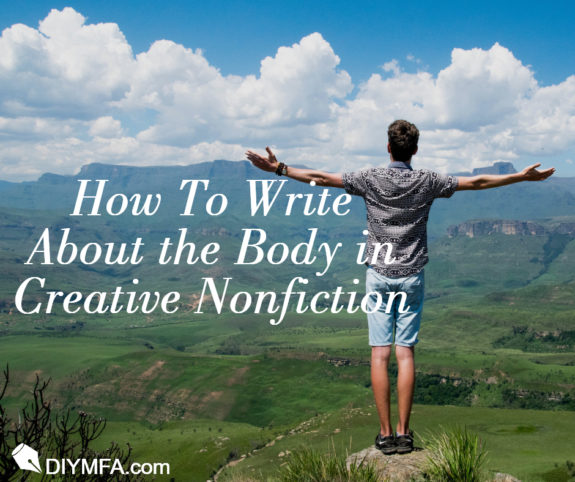Do you remember the old advice you heard from writing teachers or craft books: make all five senses—taste, touch, sound, sight, and smell—part of the scene? It may not seem like it, but this advice invites you to write about the body in such a way that your readers feel physically present in the prose.
Take this opening passage from Flaneuse by Lauren Elkin as an example (And check out my previous column for more about this book as it relates to writing creative nonfiction!):
“On a street in Paris, a woman pauses to light a cigarette. She holds up a match with one hand, its box and a glove in the other. Her tall figure aligns with the shadow of a lamp post, two forward slashes on the wall behind her as a photographer closes the shutter. She is fleeting; pausing; permanent.”
What’s so lovely about this moment is its physicality. We’re aware of Paris as a place and asked to consider it as a cultural archetype. But then Elkin takes us beyond that. She details the actions the woman must take to light the cigarette, giving the moment significance instead of delivering a reported action. The last line portrays the woman as a moving figure, and we are engaged.
This is just one example. There are so many places you can take writing about the body and physical space. Let’s get into the details.
Be in The Moment
Think about a great narrative you read recently, fiction or nonfiction, with a scene that made you feel engaged. What made it great was probably its immediacy, physicality, and inclusion of the senses. But there’s something more to writing about a moment. Sometimes it helps to imagine the moment several times as you are writing it. If you can, use tools to make you feel its immediacy.
For example, you can use Google Maps to stand on that street corner and feel the emotion of the place through you or your narrator’s eyes.
Bonus: when you’re taking a walk to inspire yourself, take this advice to heart.
Focus on Identity
Our bodies fundamentally affect our identities. The way we navigate in the world. The way we see ourselves. There’s so much more to writing about the body than simply making your readers be present. What about writing about illness, sexuality, trauma? As Ruth Ozeki says in this writer’s roundtable hosted by Literary Hub, “the body is filled with stories.” It’s definitely an element you can’t forget about when you’re a writer.
Ashley Perez also has great advice in this roundtable on writing about the body:
“As with other writing, narrow your focus. Determine what specific thing your essay is about. That one thing defines this piece of writing. Don’t worry that it defines you or all of your writing.”
In a single piece of writing, there is one you. Embody it. You may also find it helpful to research trauma, illness, or sexuality alongside your own discussion of your personal experience to inform your direction. Sometimes this step can impact the way you write the piece.
Don’t Dismiss Your Experience
In the back of your mind, you may feel that what you’re going through has already been written about. You may be surprised. Sometimes when we try to write about experience we encounter a wall of language, unsure of which figure could tell our experiences in the most compelling way. The body and language can be at odds, but writing about it is powerful.
Virginia Woolf suffered from depression, migraines, and fevers. Her work is filled with references to these moments in her life, but her essay “On Being Ill” beautifully illuminates why we should be writing about the body:
“Literature does its best to maintain that its concern is with the mind; that the body is a sheet of plain glass through which the soul looks straight and clear, and, save for one or two passions such as desire and greed, is null, and negligible and non-existent. On the contrary, the very opposite is true. All day, all night the body intervenes.”
In The Atlantic, Joe Fassler wrote about this particular Woolf essay alongside Leslie Jamison’s The Empathy Exams. When writing his first novel, Fassler’s editor told him that he wrote the word “sweat” too much and included too many mentions of plum-colored bruises. The essay is about his “daily dramas of the body,” and it’s a must-read. He writes,
“I imagined myself the bard of swelling; I wanted to write toothache lyrics for swelling—to evoke the chronic panic of its deforming sculptural practice: it shapes you into something like you, but not you. I wanted to bring that aching knowledge to my nonexistent reading public.”
Whether you are writing about illness or the experience of existing in your body, an important step is simply listening to yourself.
Essay Recommendations:
- https://granta.com/kettle-holes/
- https://lithub.com/walking-while-black/
- https://hazlitt.net/feature/year-plagues
Books:
- Hunger by Roxane Gay
- The Empathy Exams by Leslie Jamison
- Brain on Fire by Susanna Cahalan
 Kayla Dean is a Vegas-based writer, who has written for publications like Electric Literature, Darling, and Bella Grace. She has several stories and essays in the works and also blogs about writing and creativity on her personal website. Currently at work on a literary nonfiction thesis, she will receive her MA in English Literature this May. You can find her on Twitter@kayladeanwrites.
Kayla Dean is a Vegas-based writer, who has written for publications like Electric Literature, Darling, and Bella Grace. She has several stories and essays in the works and also blogs about writing and creativity on her personal website. Currently at work on a literary nonfiction thesis, she will receive her MA in English Literature this May. You can find her on Twitter@kayladeanwrites.







